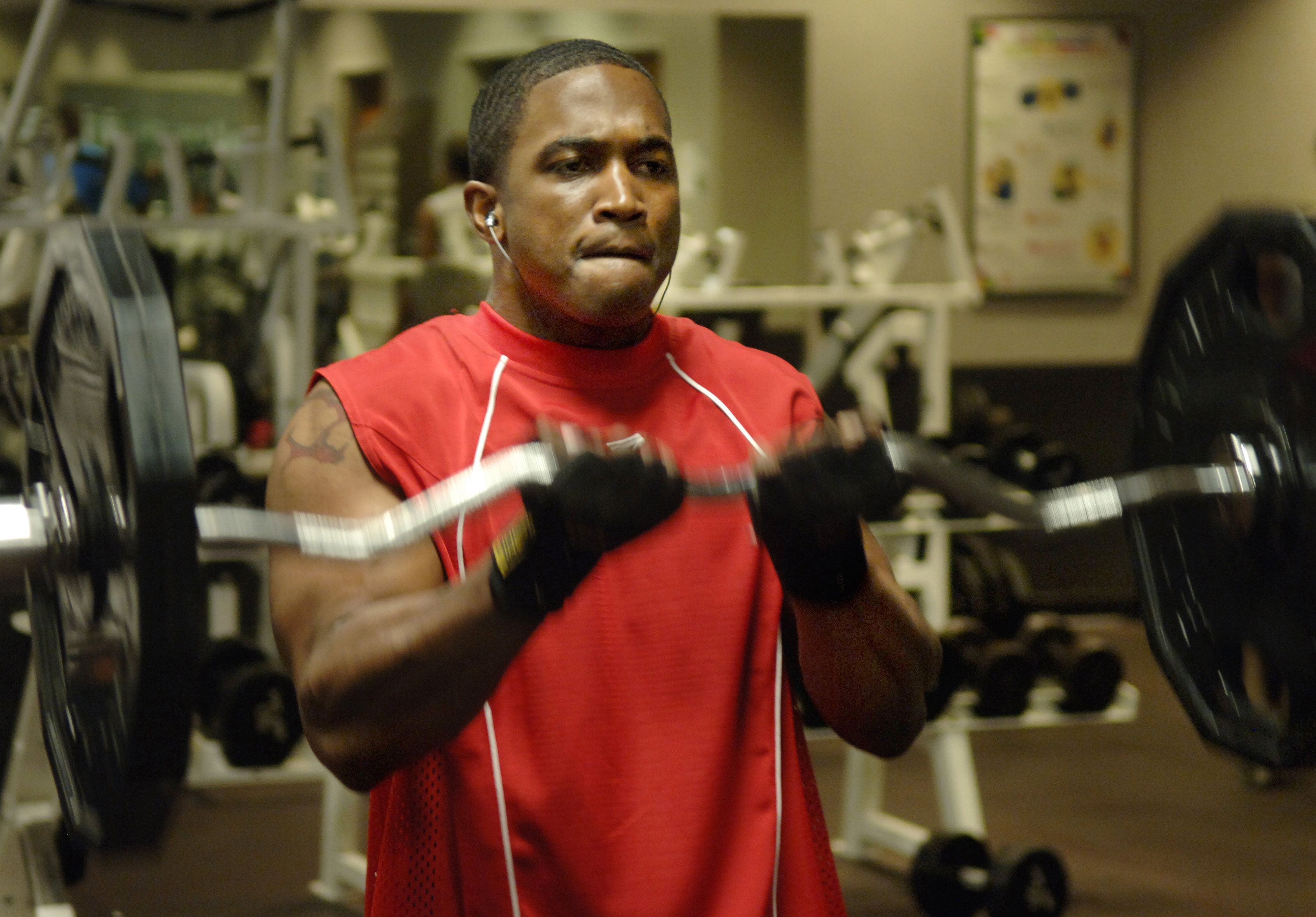
In each muscle study, we’ll take a look at a muscle group, and examine what its purpose is in the body. Then using that information, we’ll take a look at a few ways to exercise the muscle and close with a sample workout that should effectively work the muscle. There may be some biological / technical jargon in this, but I’ll do my best to explain in plain English the terminology we’re throwing around as we go along!
The biceps muscle is the muscle on the front part of the upper arm that connects the anterior (front) of the shoulder and the forearm. It consists of 1 muscle, the biceps brachii which has both a long and short head.
The Biceps Brachii

As mentioned, the biceps splits near the middle of the upper arm into a long and short head which work together as a single muscle. Each head connects to the front of the shoulder via the proximal biceps tendons. The long head connects to the supraglenoid tubercle of the scapula, which is just above the space where the humerus bone, or upper arm, enters the shoulder. The short head attaches to the coracoid process of the scapula. The two heads converge into a single muscle which attaches to the radius bone of the forearm at the radial tuberosity via a tendon called the distal biceps tendon.
So What Does This Muscle Do?
The Biceps connects to both the shoulder and the elbow, so it can affect movements governed by both joints. It is capable of:
- Supinating the hand to turn the palm upward facing
- Bringing the forearm closer to the upper arm
- Bringing the arm forward and upward
- Horizontal adduction – bringing the arm across the body
- Helping to stabilize the shoulder joint when carrying something heavy
Strong biceps muscles have a number of additional benefits when it comes to training, like decreasing the likelihood of injuries like elbow tendonitis, shoulder tendonitis or muscle tears under heavy loads.
So How Do We Best Work This Muscle?
If we look at the muscle’s primary functions, supinating the forearm and adducting (pulling) the forearm to the upper arm, we can logically determine that to get maximum flexion of the muscle, we should focus on the larger movement of adduction toward the upper arm. If you’ve trained for any length of time, you probably already know this motion as a biceps curl. Because the muscle also governs supination (turning over) of the palm, we can target different areas of the biceps by changing our hand position prior to or during a curling movement.
So let’s look at three different exercises we can do to target the muscle fully, examine why they work, and how to properly perform them to best effect.
The 3-step Alternating Supinating Dumbbell Biceps Curl

The name is quite a mouthful, but I assure you the movement itself isn’t that difficult to execute. This curl takes advantage of the wrist supination we mentioned that the biceps is responsible for to really let you work the entire biceps muscle, and a few supporting muscles as well. With this single movement, we’ll be targeting the biceps brachii, the brachialis that lies under the biceps and the brachioradialis, located in the forearm near your elbow.
When performing the exercise, your shoulders should be back and down (pinching the shoulder blades together slightly) and square with the hips. You’ll be alternating which arm performs the exercise – rather than both arms at the same time.
1Start with the weights hanging at your sides, feet shoulder width apart. knees should be slightly bent to protect the spine, and palms should be facing your hips with the wrists locked.
2Inhale and slowly raise the weight by bending your elbow and pulling your wrist toward your biceps over a slow 3 or 4 mental count. While raising the weight, begin turning your hand so that your palm is facing up when it nears the biceps. Squeeze the biceps muscle hard at the top of the movement. Pause for a 1 second mental count at the top while squeezing the muscle.
Pro-tip: near the top of the movement, really exaggerate the wrist supination so that your little finger is facing your shoulder to force a powerful squeeze of the short head of the biceps.
3Exhale and slowly lower the weight back to your sides over a mental count of 3 or 4, while returning the weight, rotate your wrist slowly back to a neutral position so that your palm is facing your hip at the bottom of the movement. Rest for a mental count of 1 or 2 and repeat the movement until failure (the point at which you cannot perform another movement, or you cannot perform another movement without sacrificing form).
The elbow should remain relatively motionless while performing this exercise. I like to imagine there’s a steel rod pinning my elbow to my side. This should prohibit any swinging of the weight (which is called cheating!) and limit any additional muscles than what we want to target from assisting too much.
The 3-Step EZ Bar Biceps Curl

This name is deceiving, it’s not easy, and if it is, up your weight! This curl works both arms together at the same time, and starts and ends with the hands in a supinated position, so we’re maximizing the impact on the short head of the biceps. Again we’ll be hitting the biceps brachii, the brachialis and the brachioradialis. It’s tough to target the biceps without involving these other muscles.
Similar to the first exercise, your shoulders should be back and down (pinching the shoulder blades together slightly) and square with the hips.
The EZ bar will offer you variations of grip width which will let you more efficiently target which head of the biceps you want to work. A close grip will target the long head (the outside) of the biceps, where a wide grip will target the short head (the inside) of the biceps. The short head is what gives the biceps muscle its ‘peak’, so both grip variations should be used.
1Stand with your feet shoulder width apart, knees should be slightly bent to protect the spine and hold the EZ bar with an underhand grip (palms facing up). Lock the wrists in place.
2Inhale and slowly bring the wrists toward the upper arms in a curling motion over a 3 to 4 count. The elbows should remain tightly at your sides. Squeeze the biceps muscle hard at the top of the movement. Pause for a 1 second mental count at the top while squeezing the muscle.
Pro tip: if you can’t raise the weight without moving your elbows, then it’s too heavy for your current strength level. Reduce the weight and focus on proper form – the strength will come.
3Exhale and slowly lower the weight back to the starting position over a mental 3 or 4 count, releasing tension on the biceps only at the bottom of the movement. Rest for a mental one second count and repeat the exercise until failure.
We intentionally take a mental one count at the bottom of each repetition to break any momentum that we may have and reset our form. This makes the movement a little more difficult, but that means it’s also a little more effective.
Incline Dumbbell Hammer Curl

This one requires a little more equipment to perform as you’ll need a bench with the ability to change its angle, but the incline dumbbell hammer curl is a great finisher for this study. Because you’re going to be in an inclined position, you won’t be able to cheat the weight up by rocking the body. Because of the angle of your body, you’ll get a great stretch on the long head of the biceps which will help to maximize the work it’s doing. Lastly, since it’s a hammer curl, you’re minimizing the strain on your wrist and elbow, protecting them from injury (just pay attention to how your shoulder is feeling, if it feels “pinch” or in pain, do not perform these!
We’re hitting the same three muscles – biceps brachii, the brachialis and the brachioradialis. But Hammer curls are going to focus a lot on the brachialis and the brachioradialis (the forearm muscles) so you’ll see some benefits here too.
1The bench should be set to around a 45 degree angle, and you’ll want to seat yourself on it with a dumbbell in each hand. Your back should be pressed firmly against the bench. Let the dumbbells hang straight down at your sides in a neutral grip (palms facing your sides).
2Inhale and raise the weights toward your upper arms over a slow 3-4 second mental count. Maintain the neutral grip on the weights and try to keep your upper arm from moving, stopping when your elbows are slightly above a 90 degree angle – don’t hit yourself with the weights. Squeeze the bicep and hold for a 1 second mental count.
3Exhale, slowly lowering the weights to the starting position over a 3-4 second mental count. Rest for a mental one second count and repeat the exercise until failure.
Focus on trying to keep the upper arm stationary through the entire movement in order to force the biceps and forearm to perform the work.
Stretch That Thing!
Strengthening the muscle isn’t good enough. You want a functional, strong, lean muscle that not only looks good, but that you can rely on. If you don’t stretch your muscles, you’ll begin developing range of motion issues that you don’t want. My rule of thumb – any time you work a muscle, you should also stretch the muscle. A few stretches you could perform after a biceps workout might be:
Standing Biceps Stretch
Biceps Post Stretch
Wrap Up
There are many reasons to exercise this muscle group, ranging from functionality to simply aesthetic reasons. Hopefully this article sheds some light on the complexity of this popular muscle group, and increases your knowledge of how it’s used by your body. I’d love to hear your thoughts on ideas how you might be able to train it to work even harder.
Know someone who might like this article? Please share it with them, or via your social media network, it helps the blog out, and you never know who you might be responsible for motivating to live a healthier lifestyle!
Resources
Web MD – Picture of the Biceps
https://www.webmd.com/fitness-exercise/picture-of-the-biceps#1
Building a biceps peak
https://www.t-nation.com/training/building-a-biceps-peak